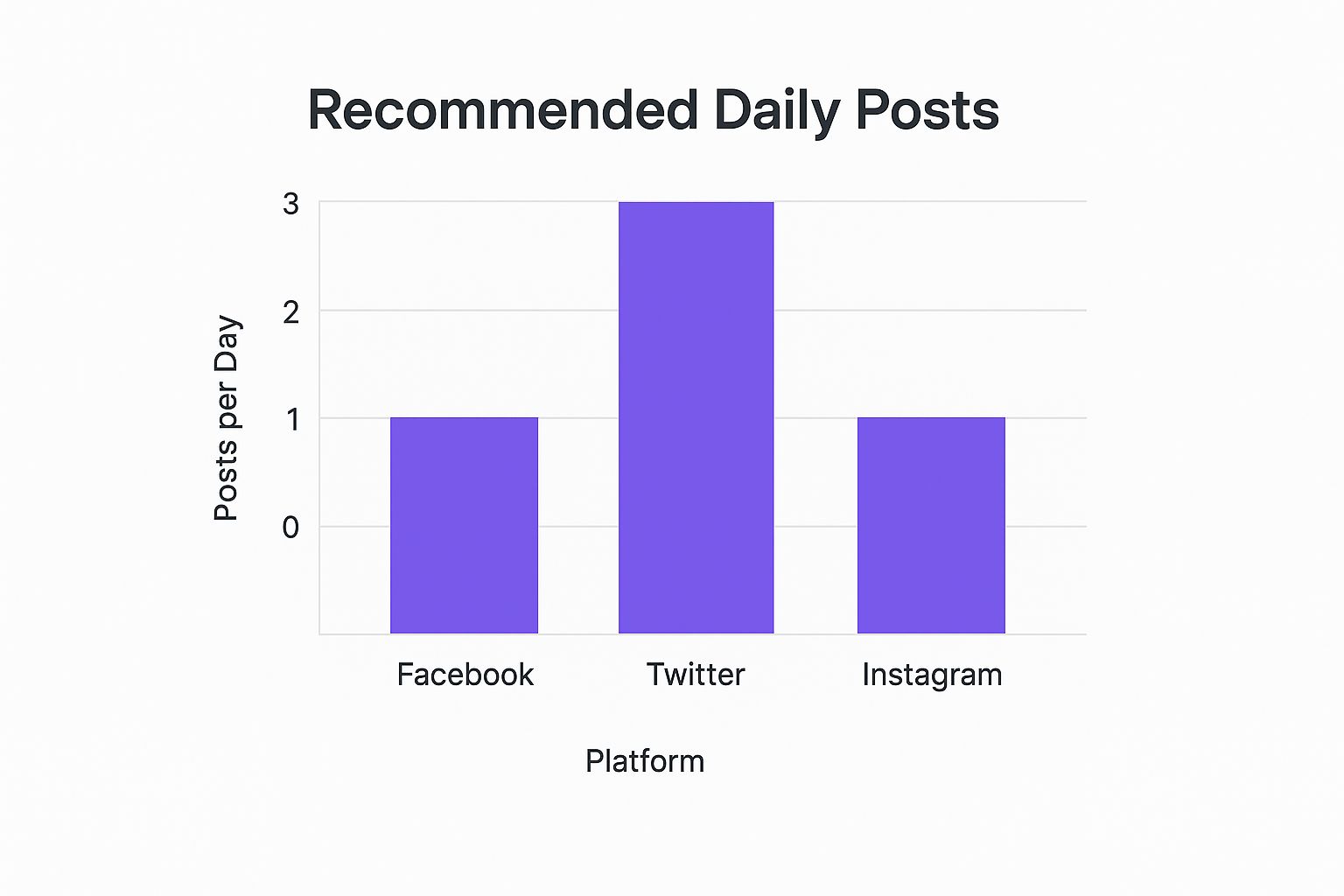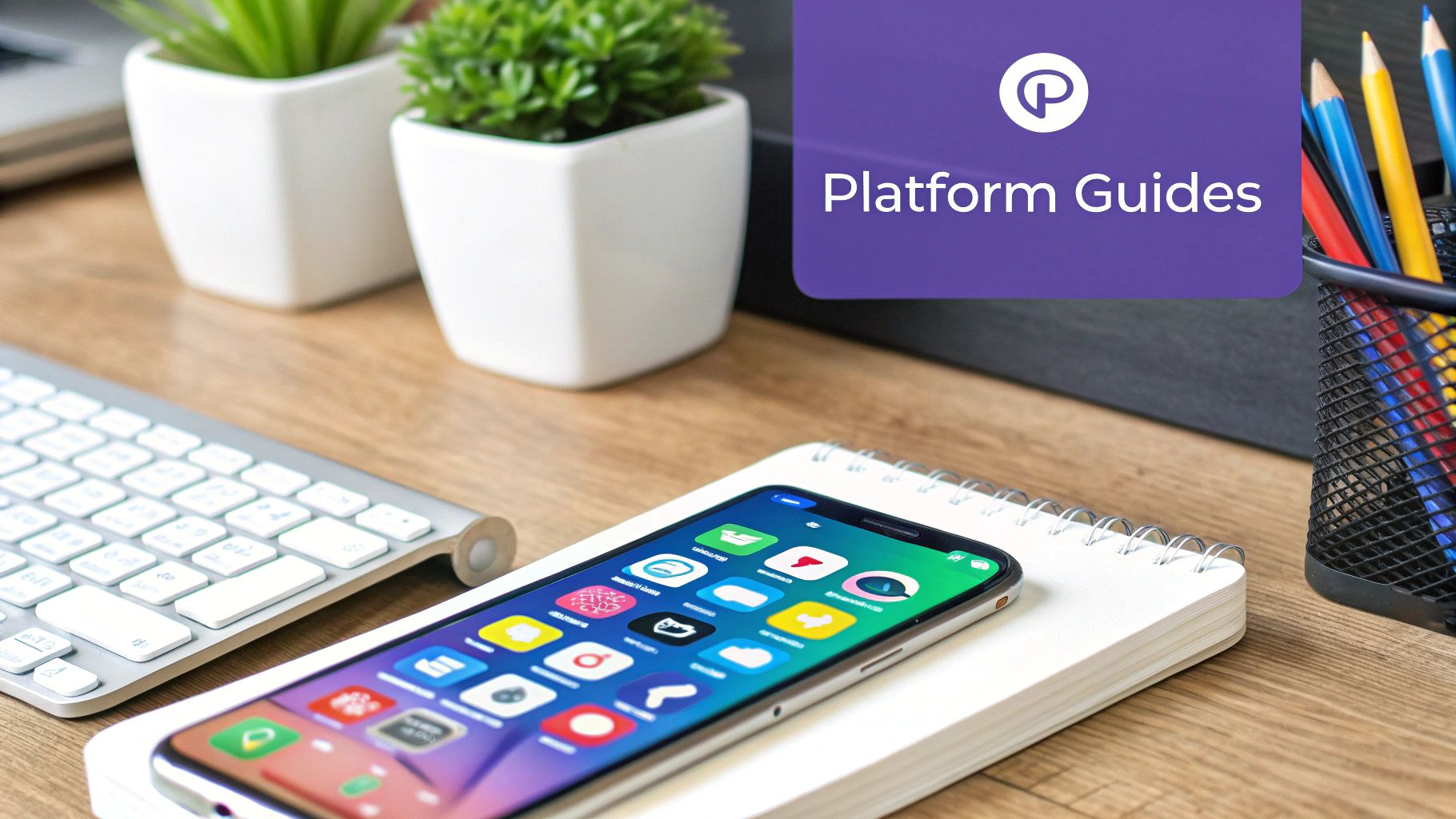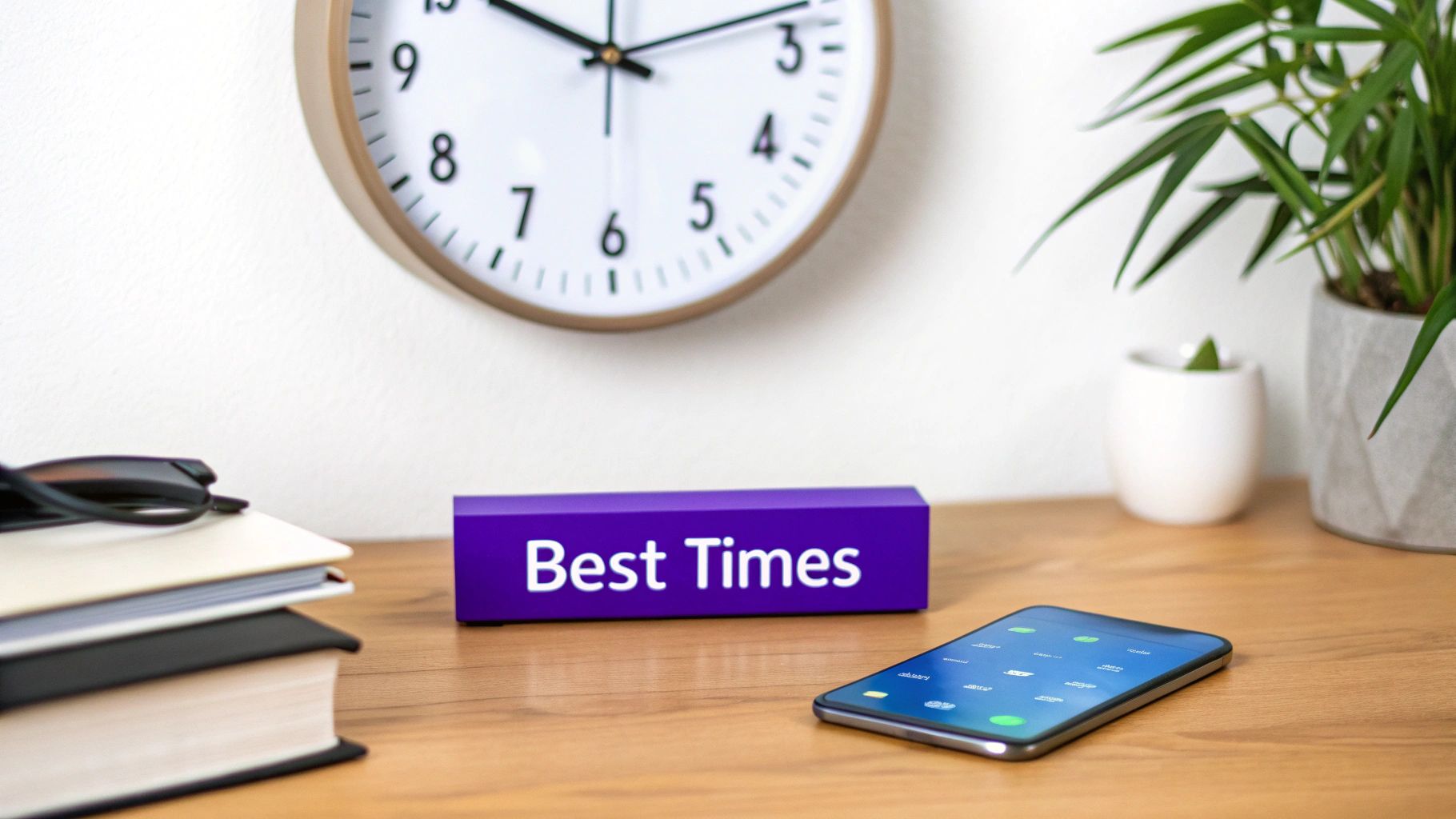How Often to Post on Social Media for Peak Engagement
Tired of guessing how often to post on social media? Learn the ideal posting frequencies for each platform and how to find your brand's perfect rhythm.
Posted by
"How often should I post on social media?"
It’s the question every marketer, founder, and creator eventually asks. The short answer? There's no single magic number. The real answer is a bit more complicated, boiling down to the platform you're on, your audience's habits, and frankly, how good your content is.
Your Guide to Social Media Posting Frequency
Finding that sweet spot between staying on your audience's radar and completely overwhelming them is a constant balancing act. If you post too little, you risk getting lost in the noise. Post too much, and you'll see follower fatigue, eye-rolls, and plummeting engagement.
The goal isn't just to post more—it's to post smarter. We need to move beyond guesswork and find a strategic rhythm that actually works for your brand.
This guide will give you some solid, data-backed starting points. More importantly, it will show you how to take those numbers and make them your own by understanding the unique quirks of each platform and, most critically, listening to what your own analytics are telling you.
Platform-Specific Posting Benchmarks
So, what are other brands actually doing? Recent data from early 2025 gives us a peek behind the curtain.
Brands on X (what we all used to call Twitter) are posting a whopping 18.1 times per week on average. Facebook is a close second at 14.2 posts weekly. Instagram is chugging along at 9.3 posts per week, with LinkedIn coming in at 5.5 and TikTok at 3.7.
This tells a clear story: faster-paced, real-time platforms demand a higher volume. If you want to dive deeper, you can explore more of these social media posting benchmarks and see how you stack up against others in your industry.
To make this even clearer, let's look at the daily recommendations.

As you can see, platforms with ephemeral, "in-the-moment" feeds like X reward a much higher posting frequency. On the flip side, algorithm-driven feeds like Instagram and Facebook are less about sheer volume and more about the quality of each post.
Recommended Social Media Posting Frequency At a Glance
Feeling a little overwhelmed? Don't be. Think of these data-informed posting frequencies as a solid starting point for your social media strategy, not a rigid set of rules. We'll dig into the "why" behind these numbers in the next section.
| Platform | Recommended Posts Per Week | Recommended Posts Per Day |
|---|---|---|
| 7-10 posts | 1-2 posts | |
| X (Twitter) | 21-35 posts | 3-5 posts |
| 3-7 posts | 1 post | |
| 2-5 posts | < 1 post | |
| 35-70 posts | 5-10 posts | |
| TikTok | 3-7 posts | 1 post |
Remember, these are just industry averages. Your mileage will absolutely vary based on your audience, your content, and your goals.
Remember, these numbers are a starting point, not a strict rule. The most successful social media strategies are built on a foundation of quality content and consistent engagement, not just hitting a post quota. True success comes from testing and finding what resonates with your audience.
Matching Your Cadence to Each Platform's Algorithm

Throwing content at the wall to see what sticks just doesn't work. I've seen it time and time again—brands either post way too much or far too little, and both lead to the same result: crickets.
That’s because posting frequency isn't a one-size-fits-all game. It’s a strategic choice you have to make for each platform, matching its unique culture and, more importantly, its algorithm. Every social network has a different feel and a different set of user expectations, which should directly shape how often you show up.
Trying to post constantly on a platform that values deep, meaningful content will just make you look spammy. On the flip side, posting once a week on a fast-paced network like X will make you completely invisible. The real magic happens when you understand the "why" behind the numbers. This is how you start posting with intent, matching your rhythm to each platform’s heartbeat.
Instagram and Facebook: Where Quality Reigns
For Instagram and Facebook, think of your feed as a carefully curated gallery, not a running diary. The algorithms on these platforms are smart. They prioritize high-engagement content over a constant firehose of updates. Your audience here expects polished, valuable, and visually compelling posts.
The latest industry data for 2025 really hammers this home. On Instagram, aiming for three to five posts per week is the sweet spot. This gives you enough chances to appear in feeds without forcing you to rush and sacrifice quality. Similarly, for TikTok, three to five posts a week is a solid goal for businesses that want to focus on high-impact videos instead of just chasing trends.
Over on Facebook, marketing strategies suggest a slightly faster pace of one to two posts daily to maintain visibility without annoying your followers. You can find more of these platform-specific benchmarks from sources like Slate Teams.
Key Takeaway: On algorithm-heavy platforms like Instagram and Facebook, your main goal should be to create content so good that the algorithm wants to show it to more people. An impressive engagement rate will always beat a high post count.
X and TikTok: The Pulse of Real-Time Content
Then you have the complete opposite end of the spectrum: platforms like X (formerly Twitter) and, to some extent, TikTok. The user experience here is all about speed, what’s trending, and what’s happening right now. The lifespan of a piece of content is incredibly short, which means you need a much higher posting frequency to stay in the conversation.
- X (Twitter): This is the king of real-time. A tweet’s lifespan can be just a few minutes. To keep your brand from disappearing, you should be posting 3-5 times per day, sometimes even more. The goal is to jump into conversations, share breaking news, and talk directly with your community.
- TikTok: While incredible quality is what makes a video go viral, consistency is what feeds the "For You" page algorithm. Posting 1-4 times daily helps you test different content ideas, hop on trends as they emerge, and stay top-of-mind with your audience.
Think about it this way: a B2B software company might post a single, in-depth article on LinkedIn each day. But a fast-fashion brand might post five times a day on X, sharing user-generated photos, running quick polls, and live-tweeting an event. The context completely dictates the cadence.
LinkedIn: The Professional's Network
LinkedIn is an entirely different beast. Your audience isn't there for memes or quick laughs; they're looking for real professional value, deep industry insights, and content that can help their careers. If you post too often here, you'll quickly damage your credibility and come off as desperate.
A thoughtful, more deliberate approach is what wins on LinkedIn. I’ve found that aiming for 2-5 high-quality posts per week is a fantastic starting point. The LinkedIn algorithm also has a longer memory—an engaging post can keep getting views and comments for days or even weeks, especially as it gets shared within professional circles.
Ultimately, your perfect posting frequency is a mix of these general benchmarks and your own audience’s behavior. And remember, when you post is just as crucial as how often. To get your timing right, check out our guide on the best times to post on social media to make sure your content lands right when your audience is ready for it.
Why Consistency and Quality Beat Quantity Every Time

It’s so easy to get obsessed with hitting a magic number of posts per week. In the rush to figure out "how often to post on social media," so many brands completely forget the most important question: is any of this content actually good?
Think of your social media feed like your favorite TV show. Would you rather get one incredible, can't-miss episode each week, or a rushed, mediocre one every single day? The same goes for your content.
Posting low-effort stuff just to check a box is the fastest way to bore your followers and watch your engagement tank. The goal isn't just to show up; it's to be consistently valuable. Shifting your mindset from sheer volume to genuine value is what separates the brands that fizzle out from those that build a real community.
Build a Content Engine You Can Actually Sustain
A sustainable strategy is your best defense against burnout. It ensures every single post you publish has a clear purpose. Trying to churn out new content every single day is completely exhausting and, honestly, leads to uninspired work.
Instead, let’s build a realistic workflow that puts quality first.
This all starts with defining your core content pillars. These are the 3-5 key themes your brand will own. If you’re a fitness coach, for instance, your pillars might be:
- Quick home workouts
- Healthy meal prep hacks
- Mindfulness and recovery tips
- Client success stories
With these pillars in place, content planning becomes so much easier. Whenever you feel stuck, just go back to your pillars and brainstorm ideas that fit. It's that simple.
Another game-changer is content batching. Stop scrambling every morning to create a post from scratch. Instead, block off a chunk of time once a week or once a month to create all your content at once. This lets you get into a creative flow state, keeps your quality consistent, and frees up the rest of your week for what really matters: strategy and engagement.
Key Takeaway: Two fantastic posts a week will always outperform ten mediocre ones. Research backs this up—quality is what drives real engagement, not just sheer volume. Focus your energy on creating content that actually resonates, not just filling a calendar slot.
Make Every Single Post Work Harder for You
You don't need to reinvent the wheel every time you post. One of the smartest ways to stay consistent without burning out is by repurposing your content.
Take your best-performing assets and give them new life.
That amazing blog post you wrote? It can become an Instagram carousel, an X thread, a short-form video for TikTok, and a professional update on LinkedIn. You’re creating one high-value "hero" asset and then adapting it for different platforms and audiences.
This doesn't just save a ton of time; it reinforces your core messages across all your channels. It's about working smarter, not harder, to keep up a high-quality presence. By focusing on creating just a handful of stellar assets each month, you can generate a steady stream of valuable content. This approach not only keeps your feed fresh but also teaches you more about how to improve social media engagement for the long haul.
Finding Your Brand’s Perfect Posting Rhythm
Industry benchmarks and best practices are a fantastic place to start. They give you a solid foundation. But to truly figure out how often you should be posting, you have to stop guessing and start listening to what your own audience is telling you.
Your unique data holds all the answers. It’s the key to unlocking a posting rhythm that actually drives results, not just checks a box on your to-do list.
This isn’t about becoming a data wizard overnight. It’s about learning to read the simple signals your followers are already sending you through native tools like Instagram Insights and Meta Business Suite. Let’s walk through how to turn that raw data into a clear, actionable posting schedule that works for you.
The Metrics That Truly Matter
Vanity metrics like your total follower count feel great, but they don't tell you much about your content's real-world performance. To find your ideal posting frequency, you need to zero in on the numbers that measure engagement and reach relative to your audience size.
Here are the key performance indicators (KPIs) you should be obsessed with:
- Engagement Rate Per Post: This is the big one. It’s the percentage of your followers who actually interacted with a specific post. A high rate means your content is genuinely resonating.
- Post Reach or Impressions: This tells you how many unique accounts saw your post. Tracking this helps you see if you’re showing up in feeds or just getting lost in the algorithmic noise.
- Follower Growth Rate: Are you gaining followers steadily, or are you seeing weird spikes and dips? This metric often correlates directly with changes you make to your posting cadence.
These numbers give you instant, honest feedback on your strategy. If your engagement rate plummets the moment you start posting more, that's a clear signal you’re prioritizing quantity over quality and need to pull back.
Pro Tip: Don’t just glance at your average engagement rate across all posts. Dig into individual post performance. You might discover that your audience loves your once-a-week video series but completely tunes out your daily memes. That's a powerful insight that should immediately shape your content strategy.
Run a 30-Day Posting Frequency Test
Honestly, the best way to find your sweet spot is to run a simple, controlled experiment. This framework will help you compare different posting schedules and see what your audience actually responds to, backed by hard data.
Part 1: Establish Your Baseline (Weeks 1-2)
First, pick a starting frequency based on those industry benchmarks we've talked about. For example, maybe you decide to post on Instagram four times per week. The key is to stick to this schedule consistently for two full weeks. No exceptions.
At the end of this period, record your average metrics. What was your average engagement rate per post? Your typical reach? This is your baseline.
Part 2: Adjust and Compare (Weeks 3-4)
Now it’s time to shake things up. For the next two weeks, you’re going to change the variable—your posting frequency. You could either ramp it up (e.g., post six times per week) or dial it back (e.g., post two times per week). Whatever you do, try to keep your content quality as consistent as possible with the first two weeks.
Once this second period is over, measure the same KPIs again. Did your engagement rate go up or down? Did your reach improve? Comparing the data from both periods will give you a clear, data-backed answer for your brand.
To pull off a test like this without losing your mind, learning how to create an editorial calendar is a game-changer. An organized plan is fundamental for maintaining consistency and finding your brand's perfect rhythm.
Using Automation and AI to Keep Your Schedule on Track
Let's be real: maintaining a consistent posting rhythm doesn't mean you have to be chained to your desk 24/7. That's a surefire recipe for burnout. Thankfully, technology—specifically automation and AI—has made it easier than ever to manage your social media calendar without overwhelming your team. This is how you free yourself up for the creative work and genuine audience conversations that actually drive growth.
Platforms like Buffer, Sprout Social, and Hootsuite are lifesavers here. They're built to help you plan, schedule, and automate your content calendar weeks, or even months, in advance. To really get a handle on your posting rhythm, you need to master automated social media posting. Doing so completely removes that daily pressure of having to post manually, ensuring you never miss a perfect time slot again.
Tapping into AI for Smarter Content Creation
Artificial intelligence isn’t some far-off concept anymore; it's a seriously practical tool for social media managers. AI can supercharge your content strategy in a few key ways, helping you hit those frequency goals way more efficiently.
Think of AI as your new brainstorming partner. It can spin up post ideas that fit your content pillars, write rough drafts for you, and even suggest a few catchy headlines. This alone can shave hours off the time you spend just staring at a blank screen. If you're looking for a more structured way to plan things out, our guide on how to schedule social media posts is a great place to start.
One of the biggest wins with AI is its ability to chew through massive amounts of data to predict the best times to post. This means you can maximize reach and engagement for every single piece of content you schedule.
Balancing Automation with Authenticity
Here's the most important part: automation is about efficiency, not faking it. The goal is to automate the mechanics of posting so you have more time for the art of engagement. You still need to be the one responding to comments, jumping into conversations, and building real relationships. That’s the stuff that can't be automated.
The impact of this balanced approach is huge. Recent 2025 statistics show that users are spending over 14 billion hours daily on social media, so showing up consistently is non-negotiable. With 90% of businesses using generative AI reporting time savings and 73% seeing better engagement, it's clear that technology is a critical piece of the puzzle. It helps you maintain that steady presence without ever having to sacrifice the quality of your content or your responsiveness, which is everything in today's always-on social world.
Common Questions About Social Media Posting Frequency

Even after you've crunched the numbers and set up a testing plan, some tricky questions always seem to pop up. You’re not alone in wondering about these things.
Let's break down some of the most common situations that can make or break your content strategy. Getting these right is the difference between just posting and truly mastering your brand's presence.
Does Posting Too Much Hurt Your Account?
This is a huge one, and something I hear all the time. The short answer is yes, but probably not how you think.
The algorithms won't directly "punish" you for over-posting. The real danger is audience fatigue. When you flood someone's feed, their brain learns to filter you out. They scroll right past.
Your engagement rate per post plummets, which sends a clear signal to the platform: "this content isn't very interesting." In turn, the algorithm shows your posts to fewer and fewer people. It's a vicious cycle.
The Real Risk: You're not just fighting an algorithm; you're fighting for your audience's limited attention. Two incredible posts a week will always, always outperform ten mediocre ones that just become part of the noise.
Should I Post on Weekends?
This comes down entirely to who you're talking to and where you're talking to them. There's no universal rule here.
For a B2B software company on LinkedIn, weekend posts often feel like shouting into an empty office. But for a fashion brand on Instagram or a recipe blog on Pinterest, the weekend is prime time.
So, how do you find out?
- Dive into your analytics. This is non-negotiable. Go into your platform's native insights and look at reach and engagement data for Saturday and Sunday. The numbers won't lie.
- Run a small test. Don't just assume. Schedule a few of your best-performing types of content over a couple of weekends. See how they stack up against your weekday posts.
For many consumer-focused brands, people have more downtime to browse, discover, and shop on the weekends. It’s a huge opportunity you shouldn't write off without seeing the data for yourself.
What If I Can’t Post That Often?
Relax. Consistency is far more important than frequency.
If all you can manage right now is two high-quality, genuinely helpful posts per week, that's infinitely better than scrambling to push out five rushed, low-value ones.
Start with a schedule you know you can stick to without burning out or sacrificing quality. As you streamline your workflow or bring on more help, you can slowly start to dial up the frequency. The goal is to create a sustainable rhythm.
Your audience values quality and knowing when to expect content from you. Don't get discouraged because a competitor is posting three times a day. Focus on your own game, create the best stuff you possibly can, and deliver it reliably. That's how you build a real following.
Ready to stop guessing and start growing? EndorseFlow combines an easy-to-use social media scheduler with powerful testimonial collection tools. Manage your content calendar, automate posts, and turn happy customers into your best marketing assets—all in one place. Start your 14-day free trial of EndorseFlow today!